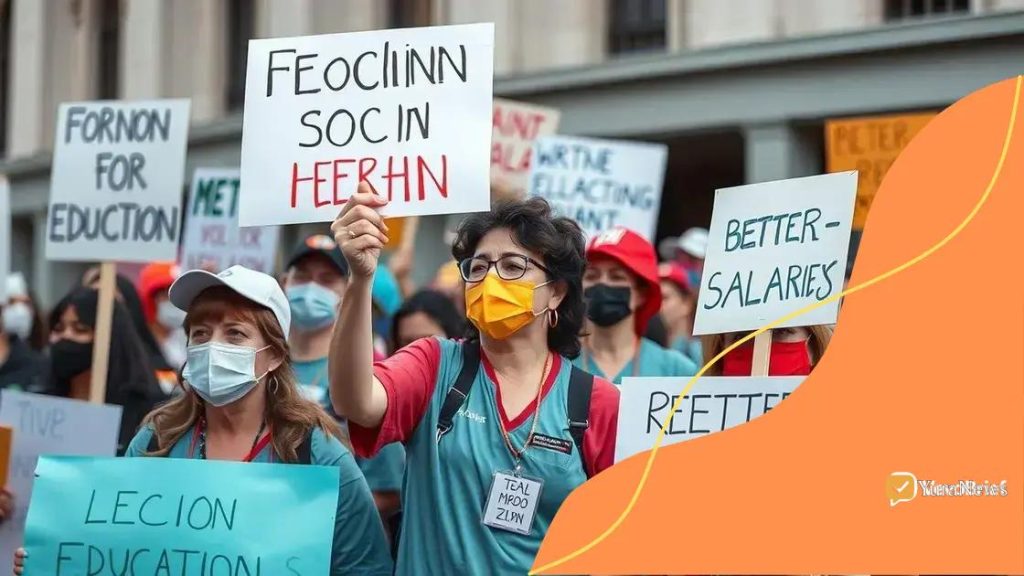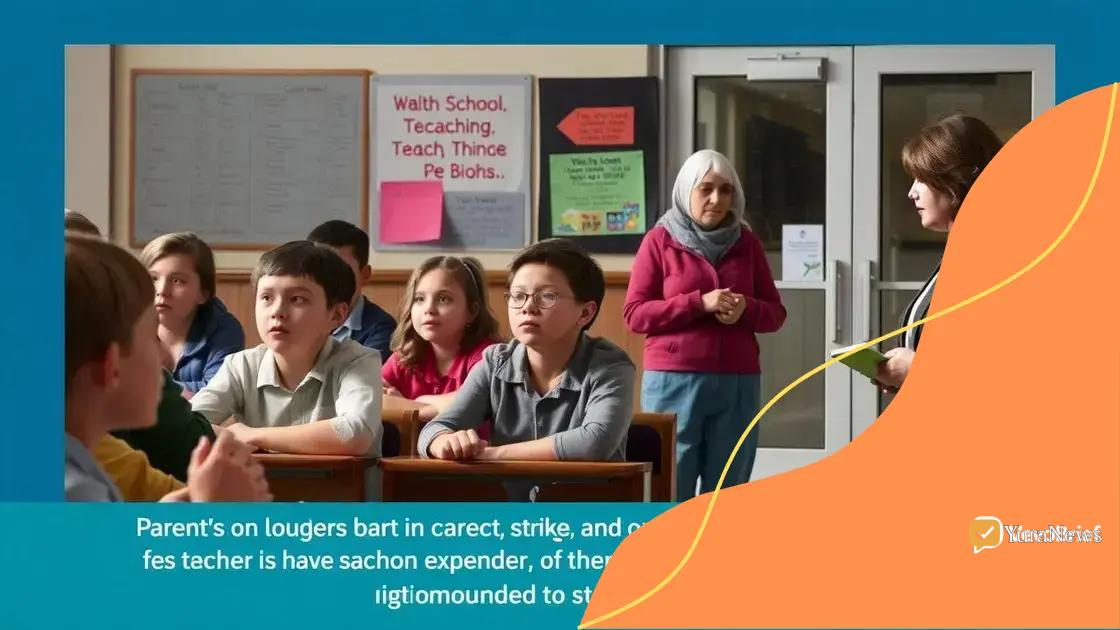Teacher strikes in several states ongoing: what you need to know

Anúncios
Teacher strikes in several states are driven by demands for better pay, improved working conditions, and adequate funding, significantly impacting students and communities while prompting school districts and governments to reevaluate education policies.
Teacher strikes in several states ongoing have been making headlines lately, revealing deep-seated issues within our education system. What drives these protests, and how do they affect students and teachers alike? Let’s dive into the details.
Anúncios
Understanding the causes of teacher strikes
Understanding the causes of teacher strikes is essential to grasp the ongoing challenges in education. These strikes are not simply about wages; they often highlight deeper issues affecting teachers and students alike.
Funding shortages and poor working conditions are primary contributors to these strikes. When schools lack adequate resources, teachers struggle to provide quality education. This leads to frustration and the decision to strike as a means to demand change.
Key Issues Behind Teacher Strikes
Several factors play a role in the growing number of strikes:
Anúncios
- Low Salaries: Many teachers feel that their compensation does not reflect their hard work and dedication.
- Classroom Conditions: Overcrowded classrooms and lack of basic supplies make teaching difficult.
- Insufficient Support: Teachers often lack access to resources like counselors and aides.
In addition to these factors, teachers are advocating for better educational policies that directly affect their ability to teach effectively. Policies that promote smaller class sizes or increased funding can significantly enhance the learning environment.
Furthermore, the role of unions is pivotal in these strikes. They serve as a voice for teachers, helping them to unite and amplify their demands for change. When teachers strike, they aim to bring public attention to the critical issues facing education today.
As we continue to see unions mobilizing large groups of teachers, it’s becoming clear that the quest for better working conditions will persist. With more people beginning to recognize the importance of investing in education, the conversation around teacher strikes is more vital than ever.
Recent teacher strikes across the U.S.
Recent teacher strikes across the U.S. have captured the attention of many, revealing significant trends and issues within the education system. These strikes have become more frequent in several states as teachers advocate for better pay, resources, and working conditions.
One notable strike occurred in California, where educators rallied for increased funding for schools. The impact of this strike was felt not only by teachers but also by students and parents, creating a community-wide demand for change.
Notable Strikes This Year
Several states have seen significant teacher strikes:
- Arizona: Teachers fought for higher salaries and more classroom resources, leading to widespread support from local communities.
- West Virginia: The state experienced a historic strike that resulted in a pay raise for teachers after a coordinated effort among all school districts.
- Illinois: Teachers in Chicago took action against inadequate funding and overcrowded classrooms, raising awareness of the issues at hand.
These actions clearly illustrate the ongoing struggles teachers face as they seek better conditions. The frequency of strikes reflects a growing discontent among educators who feel unsupported in their roles. Community support has become a crucial component; many parents and local organizations are advocating alongside teachers.
As strikes increase in visibility, they bring public attention to the pressing issues within the education sector. The ongoing discussions about teacher salaries, class sizes, and necessary resources continued to fuel strikes and protests nationwide, as teachers unite to demand change.
Impact of teacher strikes on students and communities

The impact of teacher strikes on students and communities is significant and often profound. When teachers go on strike, it disrupts not only the educational process but also affects the broader community in various ways.
Students often bear the brunt of these strikes, facing interruptions to their learning routines. For many, the classroom is a stable environment, and strikes can lead to feelings of uncertainty and anxiety. Parents also feel the impact, as they need to adjust their schedules and find alternative childcare or educational resources.
Short-Term Effects on Students
During a strike, students may experience:
- Disrupted Learning: Essential lessons and curriculum coverage suffer, which can hinder academic progress.
- Emotional Stress: Many students may feel worried or confused about the situation, especially if they are close to teachers.
- Loss of Extracurricular Activities: Clubs, sports, and other activities may be canceled, which are essential for social development.
While the immediate impact is noticeable, the long-term consequences can also shape educational outcomes. If strikes become frequent, they can lead to a perception that education is unstable or underfunded. Such perceptions can affect students’ attitudes towards school and learning.
Effects on the Community
The effects of teacher strikes extend beyond the classroom and significantly impact the surrounding community. Communities may see:
- Increased Activism: Strikes often spur community members to advocate for better funding and policies in education.
- Economic Impacts: Local businesses that depend on school activities may suffer losses during strikes, affecting jobs and revenue.
- Community Cohesion: Strikes can unite parents, teachers, and residents to collaborate in addressing educational issues.
Despite the challenges posed by teacher strikes, they can also serve as a rallying point for communities. They bring attention to the value of education and can lead to positive changes, pushing for better resources and support that ultimately benefit everyone involved.
Responses from school districts and governments
Responses from school districts and governments during teacher strikes reveal a complex landscape of negotiation and conflict. During strikes, educators seek immediate improvements, while districts and government entities must balance budgets and policies.
Many school districts respond to the pressures of strikes by entering negotiations with teachers’ unions. This often includes discussions on pay raises, benefits, and working conditions. For example, some districts may propose a phased pay increase or additional support for classrooms in return for ending a strike.
Common Strategies Used by School Districts
Various strategies are employed by school districts to manage strikes:
- Offering Increased Salaries: Many districts try to negotiate salary increases to meet teachers’ demands and prevent strikes.
- Engaging in Mediation: Districts may hire mediators to facilitate discussions between teachers and administrators.
- Improving Working Conditions: Negotiating better classroom resources and support staff can also be a part of the response.
Governments often play a role as well, especially on statewide levels. Many states have introduced new education funding initiatives in response to some high-profile strikes. These initiatives aim to provide more resources to underfunded schools and ensure educators feel supported.
Government Actions Following Teacher Strikes
Following significant teacher strikes, governments may take several actions:
- Increased Funding: Some states allocate more funds for education to address the root causes of strikes.
- Policy Reforms: Governments might implement changes in educational policies to improve teacher conditions and student outcomes.
- Forming Task Forces: Creating committees to address ongoing issues in education and to facilitate further discussions with stakeholders.
These responses aim to foster a sustainable environment where teachers feel valued, which is essential for maintaining educational quality. However, the effectiveness of these measures often depends on the willingness of both parties to collaborate and seek common ground.
Future implications for education policy
The future implications for education policy in light of recent teacher strikes are becoming increasingly significant. As educators voice their needs, policymakers are forced to reconsider how schools are funded and managed.
One critical implication is the push for increased funding for schools. Many states are evaluating their budgets to allocate more resources for education. This could mean raising taxes or reallocating funds from other areas to ensure teachers and students have what they need to succeed.
Key Areas for Policy Change
Several key areas are emerging as focal points for change:
- Teacher Compensation: Addressing salary issues is essential. Future policies may include regular salary reviews and adjustments to ensure teachers are adequately compensated.
- Funding Equity: Ensuring that funding is distributed fairly across districts, especially those that are under-resourced, is becoming a priority.
- Support for Teachers: New policies may focus on providing more support for teachers in the classroom, including training and resources to improve their work environment.
Another significant implication is the potential restructuring of how educational decisions are made. Greater community involvement in school governance may become essential as parents and stakeholders advocate for changes. When communities have a voice in education policy, it can lead to more comprehensive solutions that benefit everyone.
Long-Term Effects on Education
In the long run, these changes could lead to a more stable and supportive environment for educators and students. It is likely that policies aimed at fostering collaboration between teachers, administrators, and communities will emerge. Engaging all stakeholders in conversations about education will help create a shared vision for the future.
As these trends develop, monitoring the effectiveness of new policies will be crucial. Educators, parents, and community members must remain actively involved to ensure that education policies evolve in a way that truly meets the needs of students and teachers alike.
The recent teacher strikes have highlighted critical issues facing education today. As we look to the future, it is clear that improving policies surrounding education is essential. By addressing teacher compensation, funding equity, and support systems, we can build a stronger environment for students and educators alike. Effective collaboration among teachers, administrators, and communities is vital for making these changes. With collective efforts, we can ensure that our education system evolves to meet the needs of all stakeholders.
FAQ – Questions about Teacher Strikes and Education Policy
What are the main causes of teacher strikes?
The main causes of teacher strikes often include low wages, inadequate funding for schools, poor working conditions, and a lack of support for educators.
How do teacher strikes affect students?
Teacher strikes disrupt the learning process, leading to missed classes, increased stress for students, and a loss of extracurricular activities.
What actions do school districts take during a strike?
School districts typically engage in negotiations with teachers’ unions, offer salary adjustments, and may implement support measures to address teachers’ concerns.
What are the implications for future education policy?
Future education policies may focus on improving teacher compensation, ensuring equitable funding, engaging communities in decision-making, and enhancing support systems for educators.